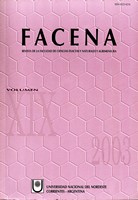Reference interval and physiological variations of plasma electrolytes in Rana Catesbeiana (Shaw, 1802, Amphibia: Ranidae)
DOI:
https://doi.org/10.30972/fac.1905509Keywords:
Rana catesbeiana, Plasma electrolytes, Physiological variationsAbstract
To obtain plasma ionogram normal values, as well as sex, age, weight, climate, and breeding and feeding systems physiological variations, 302 samples of healthy Rana catesbeiana specimens from argentine northeastern (9-21 months old, 50-350 g liveweight, 50% each sex), were analyzed. Confidence intervals for sodium (116-121 meq/l), potasssium (3.42-3.81 meq/l), chloride (100-116 meq/l), calcium (7.98-8.61 mg/dl), inorganic phosphorous (8.31-9.36 mg/dl), iron (105-178 ug/dl) and magnesium (2.26-2.55 mg/dl), were obtained. Physiological variations due to sex were not verified. Weight and age advances correlated to potassium increase, and calcium and inorganic phosphorous decrease (p < 0.05). Magnesium, potassium, inorganic phosphorous and calcium values, were lower in winter than in remaining year seasons. Ionograma was significantly influenced by handling technique; in general, values were high when tanks floor had smaller surface covered by water, and vice versa. Plasma electrolytes were low in frogs maintained on viscera, intermediate when they fed on balanced pellets plus larvas or worms, and high when they fed "naturally" in a lagoon. Utility of ionogram to evaluate nutritional and sanitary states is emphasized, and its application as useful instrument to optimize the frog production is recommended.








